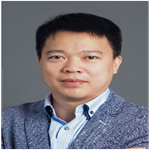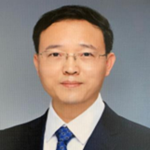Home - KEYNOTE SPEAKERS
Maria Luisa Di Vona is Professor in Chemistry at the Department of Industrial Engineering, Rome Tor Vergata University. Responsible of the Laboratory of Ionomer Materials for Energy. Italian Coordinator of the Erasmus Mundus Joint Master Degree "Chemical Nano-Engineering". Main research topics: solid state ionic conductors, synthesis of carbon materials, water treatment. She is author of about 200 publications in international journals.
Mingjun Xuan is now a scientific researcher of DWI – Leibniz-Institute for Interactive Materials and RWTH Aachen University, Germany. He obtained the Ph.D. of chemical engineering and technology from Harbin Institute of Technology in 2015. He received the award of Alexander von Humboldt fellowship. His research interests focus on mechanochemical materials, microfluidics, and micro/nanomotors as well as their biomedical applications.
Professor Benfeng Bai received his B.Sc. degree and Ph.D degree in Optical Engineering from Tsinghua University, China, in 2001 and 2006, respectively. From 2006 to 2009, he was a post-doctoral fellow at the Department of Physics and Mathematics in University of Joensuu, Finland. In 2009, he became a faculty member in the Department of Precision Instrument at Tsinghua University. He is now the principal investigator of the Nanophotonics Group with research emphases on Advanced Nano-devices, Nano-fabrication and Nano-measurement based on Near-field Optics to tackle the most urgent academic and engineering challenges and demands of the nation and the academic society. His main research contributions are in the following three aspects: (1) Advanced functional nano-devices based on near-field optics, by developing theories and experimental tools for constructing meta-devices with advanced functionalities; (2) Advanced nano-fabrication based on near-field light-matter interaction, by developing techniques for manufacturing key optical elements for high precision metrology systems such as extended area blackbodies and micro-cavity optical Kerr frequency combs; (3) Advanced near-field microscopy for nanomaterials and nanodevices characterization, by developing new principles, methods and instrumentation of near-field microscopy to address the needs of super-resolution characterization of optoelectronic properties and the detection of various nano-defects in functional nanodevices and various low-dimensional materials that are important basis materials for next-generation information and quantum applications. So far, Professor Bai has published more than 100 research papers in international journals including Nature Communications, Light: Sci. & Appl., Nano Letters, Advanced Functional Materials, Laser & Photonics Reviews, Small, etc., has given more than 20 invited presentations in international conferences, has acted as the chairs or main organizers of more than 10 international conferences, has delivered 5 short courses in international workshops and summer schools, and has been granted more than 30 international and Chinese patents. His works are widely cited, as indicated by his h-index of 32 and i10-index of 65. The total citations of his papers are 7400+ (and 4500+ since 2018), according to Google Scholar. As the responsible leader, he has led more than 10 research projects funded by the major funding agencies in China, including the Ministry of Science and Technology of China and the National Natural Science Foundation of China. He is currently serving as one of the coordinators of the Sino-French Optoelectronics and Photonics International Research Network (PHOTONET) consisting of 8 Chinese partner universities and 7 French partner universities, a board member of the National Technical Committee on Standardization of Nanotechnology of China, a board member of the Instrument Group of Micro and Nano Professional Committee of the Chinese Society for Optical Engineering (CSOE), a board member of the Powder Technology Association of Beijing, and a board member of the Metamaterial Branch of Chinese Materials Research Society. During 2014-2020, he has acted as a Topical Editor for Optics Letters, an Optica (formally OSA) journal. He has won the Award of Jin Guofan Young Scholar issued by the China Instrument and Control Society in 2011 and SPIE Community Champion issued by SPIE in 2022

Prof. Jinbo Wu is a full professor in Shenzhen MSU-BIT University and part-time professor in Shanghai University. He was selected into Shanghai Pujiang Talent Program and received the First Prize of Chongqing Science and Technology Progress Award in 2021. He serves as a member for Micro/nano-fluidic Technology Committee and Bio-MEMS Committee of the Chinese Society of Micro-nano Technology, the Electro-rheological and Magneto-rheological Committee in the Chinese Society of Theoretical and Applied Mechanics and Youth Editorial Board of Micro-Nano Letter. As a Principal Investigator, he supervised the National Natural Science Foundation of China, Shanghai Science and Technology Commission Project, Hong Kong Innovation and Technology Support Program. His research interests focus on soft materials and technology of "Making the Hard Technology from Soft Matter". He has published more than 70 papers in well-known SCI journals such as Nano-Micro Letters, Small, Engineering, etc., with more than 3000 citations. He already published one book (Functional and Intelligent Characteristics of Soft Matter and Its Applications, China Science Publishing) and 15 granted patents. His research findings attracted considerable attention and he delivered 30 invited talks in national and international conferences. The research group's website: https://www.x-mol.com/groups/wujinbo

Dr. Zhang is professor in the School of Materials Science and Engineering, Harbin Institute of Technology, China. He received his Ph.D. degree from Harbin Institute of Technology in 2002. His research interests are energy and structural materials for energy harvesting and structural applications with light weight and environmental friendship, including cathode and negative electrode materials for lithium ion battery, energy conversion materials, 4-D printing of ferromagnetic shape memory alloys (FMSMAs), physics of martensite transformation, solid-state refrigeration, 3-D printing of metal-matrix composites (MMCs), physics and chemistry in MMCs, composite interface, strengthening and toughening of MMCs. He has published over 140 academic publications in journals such as Nature Materials, Acta Materialia and Composites Part A. He also supervised a large number of research projects in the areas of FMSMAs and MMCs. His recent work focuses on the FMSMAs with multifunctional properties such as magnetic-field-induced strain, superelasticity and related elastocaloric effect (eCE), magnetic and metamagnetic transition behavior and related magnetocaloric effects (MCE) and application of such materials for room temperature cooling applications.
Prof. Amanda Ellis is the Head of the School of Chemical and Biomedical at The University of Melbourne, Australia. She is a world-leading expert in carbon nanomaterials, polymer science and DNA nanotechnologies. She graduated with a Ph.D (Applied Chemistry) from the University of Technology, Sydney in 2003. She has undertaken postdocs in the US (Rensselaer Polytechnic Institute and New Mexico State University) and NZ (as a Foundation of Research Science and Technology Postdoctoral Research Fellow at Callaghan Innovations. In 2006 she commenced at Flinders University, South Australia where she became a Full Professor (2013), an ARC Future Fellow (2014) and acting Associate Dean of Research for the Faculty of Science and Engineering (2016). In May 2017 she joined the Department of Chemical Engineering at the University of Melbourne and was the Head (2019-2022). She has secured over $30 M in funding from the ARC and non-ARC sources as well as publishing over 180 peer-reviewed publications (>7900 citations) and holds 6 patents. She is the President-Elect of the Royal Australian Chemical institute (RACI), a recipient of the RACI Margaret Sheil Women in Leadership award (2019) and has been an Australia Research Council College of Experts panel member (2017-2020).

Afshin Abrishamkar received his B.Sc. from IUT (Iran), during which he spent an exchange period at CEFET-MG (Brazil), and his M.Sc., with distinction, from LUT (Finland). He earned his Ph.D. from ETH Zurich (Switzerland), followed by postdoctoral research at PSL Research University (France) and McMaster University (Canada) prior to joining the National Research Council of Canada (NRC) as a Research Officer. He has been the recipient of several honors/awards including the IAESTE Internship Abroad Scholarship (2009), LUT Research Fellowship (2013), Excellence in Studies Award (2014), European Cooperation in Science & Technology Travel Award (2017), Meetings International Young Scientist Award (2020), and 2020 GDR Micro-Nano-Fluidics Young Researcher in Microfluidics Award (2021).
Will update soon
Will be updated soon
Prof. Zhifeng HUANG, Associate Professor at The Chinese University of Hong Kong, is Member of The Hong Kong Young Academy of Sciences, and Vice President of HK Materials Research Society. Prof. Huang is devoted to fabricating inorganic nanopillar arrays to study chiral nanoplasmonics, surface-enhanced chiroptical spectroscopies, asymmetric (photo)catalysis, optoelectronics and cell culture. He contributed two book chapters, and published his studies in high-impact journals, such as Nat. Chem., Nat. Nanotechnol., Nat. Commun., Adv. Mater., Adv. Funct. Mater., JACS, and so on. Prof. Huang co-founded a spin-off, Mat-A-Cell Ltd., to commercialize a new-generation medical nano-device for cell culture. The invention, patented in US and China, was awarded 2019 TechConnect Innovation Award and Gold Medal with Congratulations of Jury (the 46th International Exhibition of Inventions of Geneva, 2018).
Dr. Xu He-Xiu Xu is a professor of Northwestern Polytechnical University and Air Force Engineering University, China. He has published more than 160 peer-reviewed journal and conference papers. He has also published 3 Chinese books, 1 English book and 2 English book chapters. He served as an editor of AEU Int. J. Electron. Commun since 2014, a guest editor for Special Issue “Metamaterial Circuits and Antennas” of ‘International Journal of RF and Microwave Computer-Aided Engineering’ in 2018, an associate editor for Research, and IEEE Photonics Journal since 2021, served as an editorial board member of several China journals such as J. Infrared Millim. Wave, Journal of Electronics & Information Technology, Transactions of Nanjing University of Aeronautics and Astronautics (TNUAA), and Space Electronic Technology since 2021, and served as an invited reviewer for more than 20 leading journals including Light Science & Applications, etc. He has owned 30 China patents and has given more than 40 invited talks. He served as a special session chair 25 times and a TPC co-chair/member more than 20 times in international conferences. His research interests include passive/active metamaterials/metasurfaces, and their applications to novel microwave functional devices and antennas. Dr. Xu received the 8th China Youth Science and Technology Innovation Award in 2013. He receives the URSI GASS Young Scientist Award, URSI AP-RASC Young Scientist Award, and URSI EMTS Young Scientist Award and ACES Young Scientist Award in 2019, URSI GASS Young Scientist Award in 2020 and Progress In Electromagnetics Research Symposium Young Scientist Award for SC2 and SC4 in 2019 and 2021, respectively. He was also granted several Scientific and Technological Progress Awards like China Patent Award, First Prize of Invention & Innovation Award from China Association of Inventions, Gold Award of National technological invention, Special Prize of Scientific and Technological Progress Award by Education Department of Shaanxi Provincial Government and Second Prize of Scientific and Technological Progress Award by CIE. He was awarded Young Scientist Nova from Shaanxi Technology Committee in 2016, a Young Talent from China Association for Science and Technology in 2017, outstanding scientific and technological worker of CIE in 2018, Technical Star Award by the Government of Xi’An, Outstanding Young Talent Award in Universities by the Education Department of Shaanxi Provincial Government and Young top talents of Shaanxi special talents supported by the Government of Shaanxi Province in 2019, and Cheung Kong Scholar in 2020. He was also the receipt of Excellent Paper Award in metasurface multifunctional devices at the 23th Annual Youth Conference of CIE in 2017, in helicity control of metasurface at PIER Symposium in 2018, Outstanding Paper Awards from Light Science & Applications in 2019 and from Research in 2022, The 14th Excellent Scientific Paper Award from Shaanxi Government in 2019, Annual Excellent Research Paper Awards from CIE in conformal metasurface in 2020 and multiplexing metasurface in 2022, and a co-recipient of three Best Paper Awards such as in bifunctional metasurfaces at the A3 Metamaterials Forum in 2017. He is ranked 2‰ in World Ranking of Scientists and Elsevier Global Highly Cited Scientist from 2020 to 2022. Dr. Xu is now also a Fellow of IET, a Senior Member of CIE, and a committee member of antenna branch of CIE.
Dr. Jianxin Geng is a professor in Tiantong University and the dean of the School of Material Science and Engineering. He obtained his PhD from Changchun Institute of Applied Chemistry, Chinese Academy of Sciences (CAS), in 2004. Prof. Geng has broad research interests, including polymer science, carbon nanomaterials, and electrochemical energy storage. He received a number of prestigious awards and honors, including the “National High Level Talents Special Support Plan” of China (2017), the CAS “Hundred Talents Program” (2012) and “excellent” rating in the final review of the program (2016), the “Leading Talents for Technological Innovation” by the Ministry of Science and Technology of the People's Republic China (2015), and the “Shuangchuang” Program of the Jiangsu Province of China. He has more than 100 peer-viewed papers published in highly prestigious journals including Nat. Commun., J. Am. Chem. Soc., and Angew. Chem. Int. Ed.. He has applied for 18 Chinese patents and 1 PCT patent and 9 of the Chinese patents are granted. He has 1 book chapter published.
Jianjun Tian is a professor, and vice-dean of Institute for Advanced Materials and Technology, University of Science and Technology Beijing. He is member of editor board of Science China Materials, and Int. J. Miner. Metall. Mater. Current research focuses on quantum dots and perovskites, and their applications in light emitting, solar cells and photodetectors. He published more than 150 peer-reviewed papers in high impact journals, such as Science, Adv. Mater., Angew. Chem. Int. Ed., Nano Lett.
J.W. McPherson holds a PhD degree in Physics and is an IEEE Fellow. He is recognized internationally as an expert in Reliability Physics & Engineering. He has published over 200 papers on reliability physics and awarded 20 patents. Dr. McPherson worked for Texas Instruments for 30 years and retired as a TI Senior Fellow. He authored a reliability textbook that is widely used by students and practicing engineers: Reliability Physics and Engineering, Springer Publishing (now in its 3rd Edition, 2019). Presently, Joe is Founder & CEO of McPherson Reliability Consulting, LLC.
Dr. Wenbo Peng is now an Associate Professor at School of Microelectronics, Xi’an Jiaotong University. He received his PhD degree in major of Electronic Science and Technology at 2016 and bachelor degree in major of Microelectronics at 2010, from Xi’an Jiaotong University. He has been a visiting scholar in School of Materials Science and Engineering, Georgia Institute of Technology from Aug 2014 to Jul 2016, working on the research fields of piezotronics and piezo-phototronics under the supervision of Prof. Zhong Lin Wang. His research interests mainly focus on advanced low dimensional piezoelectric semiconductor materials, devices and physics, and novel intelligent sensing integrated chips. He has received several fundings from NSFC, Shaanxi Province and companies. He has authored and co-authored over 50 peer-reviewed journal publications in related research fields, parts of which are published on high quality international journals, including Advanced Materials, Advanced Functional Materials, Advanced Energy Materials, Nano Energy, ACS Nano, Nano Letters, etc. His publications have been cited over 2400 times, as documented at Google Scholar (h-index: 26). He has given several Keynote/Distinguished/Invited Talks in renowned international conferences. He is the Fellow of International Association of Advanced Materials.
As the head of Clinical Medicine Department, Xuesong Yang is currently a professor at Histology & Embryology Division, Medical College, Jinan University, China. His research interests contain: 1) Biomedical research: etiology and pathology of birth defects. 2) Medical education research: pedagogical research on medical education. So far, he has published 170 SCI academic papers in the scholarly journals including Developmental Cell, PNAS, Current Biology and Development, Environment International, Anatomical Sciences Education, Medical Education Online etc.
Dr. Pradip Das is a Royal Society-Newton International Fellow at the University of Southampton, United Kingdom. He received his M.Sc. in Chemistry from the Indian Institute of Technology Kharagpur, India. He completed his Ph.D. research work at the Indian Association for the Cultivation of Science, India. He conducted his postdoctoral research at the University of Toronto Mississauga, Canada, the University of Milano-Bicocca, Italy, the Italian Institute of Technology Genova, Italy, and the Institute Charles Gerhardt Montpellier, CNRS, France. His research is focused on the development of nanomaterial-based approaches for diagnosis and therapy. He has published 27 peer-reviewed papers that have been cited more than 1590 times.